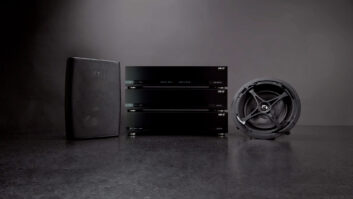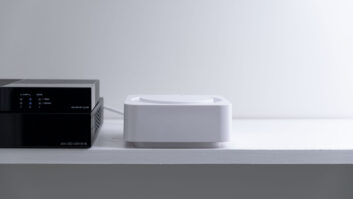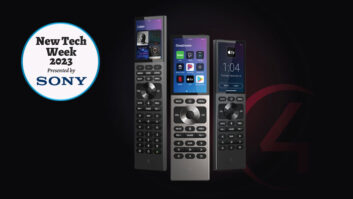Growing up, two audio components held near-mythic quality in the Valhalla of my mind. The first was the Nakamichi Dragon tape deck–a component with so many buttons, knobs, LEDs, and settings that it was a mix-tape maker’s marvel. The second was a set of Stax electrostatic headphones–they were so high-end and exotic, cost many thousands of dollars, required their own amplification system, and were stratospherically beyond my reach.
Today, electrostatics are still recognized among the ultimate in headphone technology design, and they are continue to be fairly uncommon and pricey. Certainly the most well-known–and extreme– example of this design is Sennheiser’s HE1, aka the Orpehus II. These phones feature an external tube amplification system that is truly a glory to behold and cost roughly the same as a 5-Series BMW.
While these models have breathtakingly open and airy sound, incredibly fast transients, and amazingly low distortion levels, all electrostatics so far have been large, over-the-ear models with open back designs. While these might work great sitting at home in an uber-quiet listening room, they basically suck for use in public. They are bulky, and you can hear almost everything happening around you, while the people around you also hear everything on your playlist.
Shure’s in-ear monitor designs are highly regarded, and over the past eight years the company has developed the world’s first sound-isolating, inear electrostatic earphones. Incredible miniaturization was needed to make an in-ear electrostatic work, as the Mylar diaphragm has 2/1,000-inch separation between the stator plates. Further, the diaphragms used on the KSE1500s are so thin and light that it would take 15,000 of them to equal the weight on one penny.

Without reservation, I can say the Shure KSE1500s produced the finest audio experience I’ve ever enjoyed.
At $3,000, the new KSE1500s certainly aren’t cheap. You would expect such a luxury item to arrive in a decent “presentation case,” and they don’t disappoint. The first impression is definitely one of the luxury and style in a black box with the phones and separate DAC/amplifier well-packed on top with a slide-out drawer below holding a generous number of accessories supporting nearly any listening experience. Among the included “goodies” are eight different tips for the earphones, mini-cables, and USBs of different lengths and connections, a mini-to-quarter-inch and airline adapter, carrying case, and a sturdy leather carrying case for the DAC/amp in a rich burnt sienna color that reminded me of Hartmann luggage.
The electrostatic phones require about 200 volts of DC bias on the diaphragms and +/-200 volts signal at the stators to function, meaning they can’t be connected directly to a source component. Instead, the phones connect via a six-pin LEMO connector to the DAC/amplifier. This connection is tight, and I never had any issues with it coming loose. The DAC handles 16 and 24-bit audio, with sample rates up to 96 kHz, and can drive the phones to max-rated SPL of 113 dB. In practice, I rarely had the volume beyond 15-18 (out of 25), which produced plenty of output. Because of the phones’ impressive sound isolation performance, you can enjoy at lower volumes.
The amp features five EQ presets (flat/bypass,, low boost, vocal boost, loudness, de-ess) as well as four user-defined presets offering four-band parametric equalization to fine tune the audio to taste. The amp’s rechargeable Li-Ion battery is rated at 10 hours of operation via analog inputs and seven hours via USB. I didn’t give it an endurance test, but found it to live up to these claims. It smartly doesn’t charge when connecting to a phone– saving my iPhone 6’s anemic battery from an even earlier death–but does automatically charge when connected to a computer. At 6.42 ounces, the amp is about the size of a deck of cards and fits comfortably into a jacket pocket, and the carrying case has a belt loop should you prefer that method. Even still, using these phones will require carrying and charging another device, which may be a drawback to some. My biggest complaint with the amp is that the superior USB connection is on the bottom while the LEMO headphone connection is on top, meaning cabling extrudes from both ends, making it far less pocket friendly.
As with any in-ear phone, fit is critical to proper performance, especially bass reproduction. Getting a good, comfortable seal with the KSE1500s proved a bit challenging for me at first because the last few inches of cabling into the phones is quite thick and stiff and its weight kept pulling the phones out of my ears. After watching a Shure video on how to properly wear the phones, however, I bent/molded the wire around my ears, found the correct in-ear tips, and voila! Once properly inserted, the phones fit snugly and securely and delivered roughly the same level of sound isolation as sticking your fingers into your ears. While the kit includes a generous number of tips, if I were purchasing these, I would definitely invest the $150 to get a set of custom-made sleeves from Sensaphonics, Shure’s preferred provider.
While I found them comfortable for extended listening sessions, I had difficulty getting them to stay in when lying down. And although it might seem like the height of opulence to go jogging with a $3,000 pair of electrostats, the phones come with a cable clip that keeps the thick and tangle-free Kevlar cord in place during your workout.
So, how do they sound? In a word, magnificent. In more words, stunning, revelatory, focused, and hyper-detailed. The KSE1500’s sound is less like peeling back the layers of an onion, and more like putting your favorite music under an electron microscope where it is presented in perfect detail, focus, and clarity. You can isolate any instrument, performer or minute detail you chose. I can’t tell you how often I would be listening with my eyes closed and I’d catch myself “looking” in the direction of a performer I wanted to focus on.
While the KSE1500’s reveal micro details and subtle nuances in every song you listen to, their incredibly fast response and stunning high-frequency detail makes them wonderfully suited to enjoying less-processed material, such as jazz, classical, and female vocals. Whether it is the decay on a cymbal crash, the texture of a metal brush, the sound of the hammer striking a piano string, or the nearly buried sound of a vocalist opening her mouth before singing, if it is in the recording, the KSE1500s present it to you. Unfortunately, that also goes for anything “untoward” in the recording, laying bare and spotlighting errors made on bad recordings, as well.
A common criticism of electrostats is their inability to produce deep bass, but due to the earphone being in the sealed ear cavity, low-end response is quite decent and rated down to 10 Hz. While these certainly aren’t bass heavy in any way, I felt the bass had a similar “audiophile” quality that I noticed of truly high-end speakers at the Venetian at this year’s CES.
Without reservation, I can say the Shure KSE1500s produced the finest audio experience I’ve ever enjoyed. And that you can stick them in your pocket and enjoy that experience at any time and in any place is all the more incredible. Is $3,000 a lot? Maybe. But compared with building a high-end home listening system, it is a drop in the bucket. The KSE1500s offer an audiophile listening solution not completely out of a music lovers’ reach, and would be especially appealing to people unable to enjoy a traditional system at volumes that would disturb neighbors, or who commute regularly and demand the ultimate in audio and portability.
800.257.4873
shure.com
Kudos
Truly stunning audio quality; great sound isolation
Concerns
Pricey; carry/charge separate amp/DAC
Product Specs
► World’s first in-ear sound isolating electrostatic earphone system
► Frequency response 10 Hz-50 kHz
► Maximum SPL 113 dB
► Amplifier S/N 107 dB A-weighted, -40 to +60 dB range
► 16/24-bit depth, 44.1/48/88.2/96 kHz sampling
► Rechargeable Li-Ion battery (7 hours USB; 10 hours mini-jack)
► Amplifier Dimensions: 4.37 x 2.32 x .83 (Hx W x D)-inches; 6.42-ounces







